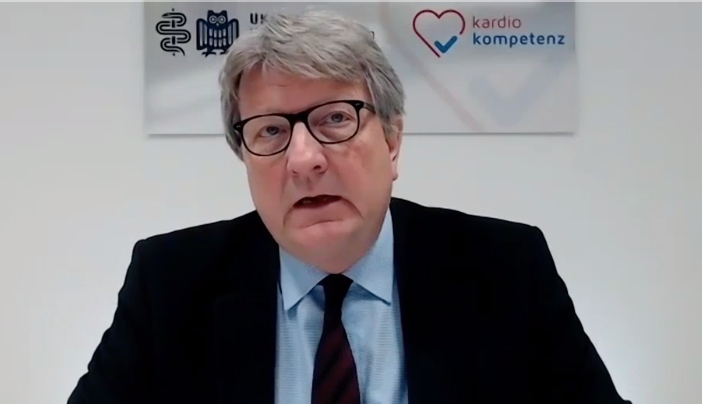 Prof Michael Böhm
Prof Michael BöhmCatheter-based renal denervation (RDN), used without antihypertensive medications, significantly lowers blood pressure (BP) in patients with uncontrolled hypertension without major adverse events (AEs), according to results of the SPYRAL HTN-OFF MED Pivotal trial presented at the American College of Cardiology and World Congress of Cardiology virtual meeting (ACC.20/WCC).
Among 331 patients with office systolic BP (SBP) of ≥150 mm Hg and <180 mm Hg, or 24-hour mean SBP of ≥140 mm Hg and <170 mm Hg on ambulatory BP monitoring (ABPM), 166 patients were randomized to undergo RDN, while 165 were assigned to undergo a sham procedure. Both procedures were performed when the patients were off antihypertensive medications, ascertained by urine and serum testing. A Bayesian design was used, with the primary analysis combining evidence from the previously reported pilot trial (n=80) and the current pivotal trial (n=251). [Böhm M, et al, ACC.20/WCC, abstract 406-15; Lancet 2020, doi: 10.1016/S0140-6736(20)30554-7]
At 3 months, the primary efficacy endpoint of change in 24-hour SBP was -4.7 mm Hg in the RDN group vs -0.6 mm Hg in the sham control group (difference, -4.0 mm Hg; p<0.001). The secondary efficacy endpoint of change in office SBP was -9.2 mm Hg in the RDN group vs -2.5 mm Hg in the sham control group (difference, -6.6 mm Hg; p<0.001). The treatment effects of RDN on 24-hour SBP and office SBP were consistent between patients from the pilot and pivotal trial cohorts.
“Bayesian primary analysis showed a between-group difference in 24-hour SBP of -3.9 mm Hg and office SBP of -6.5 mm Hg, with >99.9 percent probability of superiority of RDN,” reported investigator Professor Michael Böhm of the Saarland University, Homburg (Saar), Germany.
“ABPM data showed significant reductions in 3-month mean SBP from baseline in the RDN group at all time points of the day,” he continued. “Most interestingly, at night time and in the morning – periods of the day that are most closely associated with cardiovascular [CV] outcomes – the significant reductions in SBP seen with RDN were similar to the total reduction seen over 24 hours and the reduction seen during day time [all p<0.001].”
In contrast, the 3-month mean and baseline SBP readings in the sham control group were comparable at all time points of the day.
“The efficacy of RDN, in terms of 3-month change in 24-hour SBP, was consistent across subgroups, including in patients with type 2 diabetes mellitus,” said Böhm.
Patients (mean age, ≥52 years; about two-third male) in the trial had a mean 24-hour SBP of ≥151 mm Hg, a mean office SBP of ≥162 mm Hg, and a mean diastolic BP of ≥98 mm Hg. Those with type 1 or type 2 diabetes mellitus and an HBA1c >8 percent were excluded, as were those with renal failure, secondary causes of hypertension, or ineligible renal artery anatomy.
“The RDN treatment given in the trial was rather intensive, with 46.9 ablations deployed per patient. The mean number of main renal arteries and branches treated was 2.2 and 5.8, respectively, with a high volume of contrast medium used [208.7 cc],” said Böhm.
“Of note, no major device-related or procedural-related AEs were reported up to 3 months,” he reported.
More patients in the sham control vs RDN group had an excessive increase in BP and had to withdraw from the trial (17 percent vs 9.6 percent; p=0.049). In addition, follow-up was limited to 3 months, after which antihypertensive medications had to be restarted for safety. “The effect of RDN might have been disadvantaged by these study limitations,” Böhm suggested.
“Compliance with the off-medication protocol was high overall. While antihypertensive drugs were detected in 36 patients, consistent results were seen in the per-protocol analysis,” he added.
“The BP reductions seen with RDN at 3 months were significant and clinically meaningful in this population of patients with uncontrolled hypertension who were off medications. The BP reductions provided by RDN were ‘always on’ for 24 hours, independent of patients’ adherence to medication, and consistent in time points of the day when CV risk was the highest,” he concluded.
The SPYRAL HTN-ON MED trial is currently enrolling to evaluate the effect of RDN in patients with uncontrolled hypertension who are on standard medical therapy. [https://clinicaltrials.gov/ct2/show/NCT02439775]